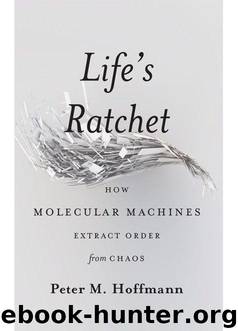Life's Ratchet: How Molecular Machines Extract Order from Chaos by Hoffmann Peter M

Author:Hoffmann, Peter M. [Hoffmann, Peter M.]
Language: eng
Format: epub
ISBN: 9780465033362
Publisher: Perseus Books Group
Published: 2012-10-29T16:00:00+00:00
Reversibility
In 1918, Smoluchowski (posthumously) published a paper titled, “About the Concept of Chance and the Origin of the Laws of Probability in Physics.” When this paper was published, the kinetic picture of matter, pioneered by Maxwell and Boltzmann, was already solidly accepted. Even the old critics, who had given Boltzmann such a hard time, had grudgingly accepted the existence of atoms and molecules. Probability now reigned supreme in theories of gases and liquids. The final blow to the anti-atomists was Perrin’s experimental results, which completely confirmed the Einstein-Smoluchowski theory of Brownian motion.
Yet, just a few decades earlier, Boltzmann seemed to be fighting a losing battle. The kinetic theory was heavily criticized. One of the main objections was what Manfred Eigen would much later call Loschmidt’s demon. Boltzmann had tried to show that the second law was a direct result of the motions of atoms—in other words, even in the case of just a few interacting atoms, the second law would hold. Boltzmann reasoned as follows: If molecules were initially in some low-entropy state, their collisions with other molecules would make their distribution of velocities more random, and increase entropy. However, the Austrian physicist Josef Loschmidt (1821–1895), a friend of Boltzmann’s, pointed out that if that were true, what would happen if we reversed time? Loschmidt’s demon was a powerful creature that could reverse time at will. In the realm of atoms, a collision obeys all known laws of physics, no matter if you play time forward or backward. Think of two billiard balls: Ignoring the player and the cue, concentrate on the moment when the two billiard balls collide. If you were to film this instant and play it to an audience forward or backward in time, it would be impossible to tell which is which. Simple elastic collisions, like collisions between molecules, are time reversible—they look the same run forward or backward. With this in mind, how could a time-irreversible law, like the second law, emerge from the reversible mechanics of molecules?
The answer to this conundrum was twofold. First, for molecules to move toward a more probable velocity distribution, they must be starting out with a less probable distribution. Thus, to see the second law in action, we have to assume that initially, the velocity distribution was improbable, and the entropy low. Then collisions shook things up, making the distribution more probable and increasing entropy. Thus, irreversibility came from the fact that the initial system was not at equilibrium. That is, it was not in a state of maximum entropy. This has consequences for the entire universe we live in: If there is such a thing as the arrow of time, which points from past to future, this arrow can only be there because the universe started in a very low-entropy state. Stars, galaxies, planets, and living beings have been feeding off the low entropy ever since.
The second part of the answer to how irreversibility can emerge from the reversible mechanics of particles is that the system has to be large enough—must contain enough molecules—so that collisions always mix things up.
Download
This site does not store any files on its server. We only index and link to content provided by other sites. Please contact the content providers to delete copyright contents if any and email us, we'll remove relevant links or contents immediately.
Enlightenment Now: The Case for Reason, Science, Humanism, and Progress by Steven Pinker(7271)
A Journey Through Charms and Defence Against the Dark Arts (Harry Potter: A Journey Through…) by Pottermore Publishing(4789)
The Immortal Life of Henrietta Lacks by Rebecca Skloot(4548)
A Journey Through Divination and Astronomy by Publishing Pottermore(4363)
Elon Musk by Ashlee Vance(4082)
Origin Story: A Big History of Everything by David Christian(3665)
COSMOS by Carl Sagan(3585)
Alchemy and Alchemists by C. J. S. Thompson(3480)
Bad Pharma by Ben Goldacre(3395)
Enlightenment Now by Steven Pinker(3349)
Shadow of Night by Deborah Harkness(3324)
Inferior by Angela Saini(3293)
A Mind For Numbers: How to Excel at Math and Science (Even If You Flunked Algebra) by Barbara Oakley(3251)
Origin Story by David Christian(3169)
The Code Book by Simon Singh(3123)
Signature in the Cell: DNA and the Evidence for Intelligent Design by Stephen C. Meyer(3097)
The Elements by Theodore Gray(3025)
A Brief History of Time by Stephen Hawking(2990)
A Journey Through Potions and Herbology (A Journey Through…) by Pottermore Publishing(2836)
